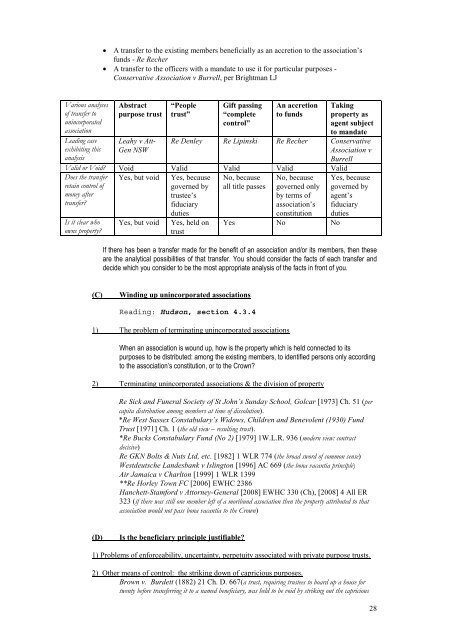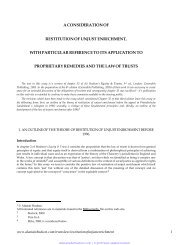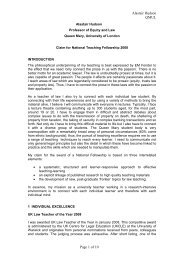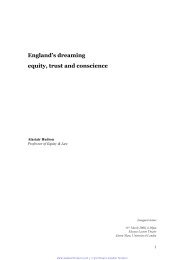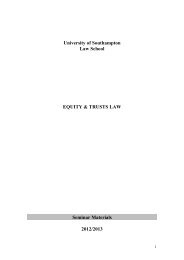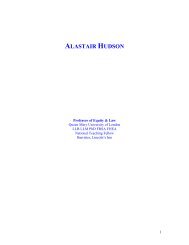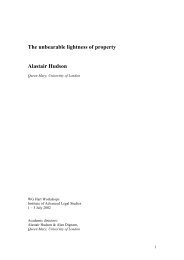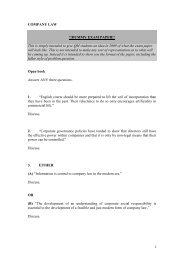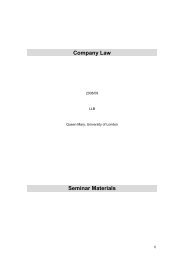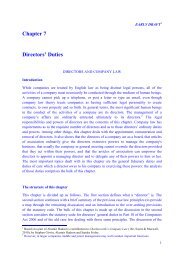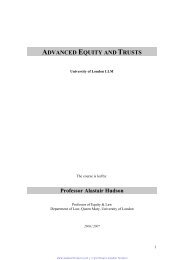Soton Equity and Trusts - alastairhudson.com
Soton Equity and Trusts - alastairhudson.com
Soton Equity and Trusts - alastairhudson.com
Create successful ePaper yourself
Turn your PDF publications into a flip-book with our unique Google optimized e-Paper software.
A transfer to the existing members beneficially as an accretion to the association’s<br />
funds - Re Recher<br />
A transfer to the officers with a m<strong>and</strong>ate to use it for particular purposes -<br />
Conservative Association v Burrell, per Brightman LJ<br />
Various analyses<br />
of transfer to<br />
unincorporated<br />
association<br />
Leading case<br />
exhibiting this<br />
analysis<br />
Abstract<br />
purpose trust<br />
“People<br />
trust”<br />
Gift passing<br />
“<strong>com</strong>plete<br />
control”<br />
An accretion<br />
to funds<br />
Taking<br />
property as<br />
agent subject<br />
to m<strong>and</strong>ate<br />
Leahy v Att-<br />
Gen NSW<br />
Re Denley Re Lipinski Re Recher Conservative<br />
Association v<br />
Burrell<br />
Valid or Void? Void Valid Valid Valid Valid<br />
Does the transfer<br />
retain control of<br />
money after<br />
transfer?<br />
Is it clear who<br />
owns property?<br />
Yes, but void<br />
Yes, but void<br />
Yes, because<br />
governed by<br />
trustee’s<br />
fiduciary<br />
duties<br />
Yes, held on<br />
trust<br />
No, because<br />
all title passes<br />
No, because<br />
governed only<br />
by terms of<br />
association’s<br />
constitution<br />
Yes No No<br />
Yes, because<br />
governed by<br />
agent’s<br />
fiduciary<br />
duties<br />
If there has been a transfer made for the benefit of an association <strong>and</strong>/or its members, then these<br />
are the analytical possibilities of that transfer. You should consider the facts of each transfer <strong>and</strong><br />
decide which you consider to be the most appropriate analysis of the facts in front of you.<br />
(C)<br />
Winding up unincorporated associations<br />
Reading: Hudson, section 4.3.4<br />
1) The problem of terminating unincorporated associations<br />
When an association is wound up, how is the property which is held connected to its<br />
purposes to be distributed: among the existing members, to identified persons only according<br />
to the association’s constitution, or to the Crown?<br />
2) Terminating unincorporated associations & the division of property<br />
Re Sick <strong>and</strong> Funeral Society of St John’s Sunday School, Golcar [1973] Ch. 51 (per<br />
capita distribution among members at time of dissolution).<br />
*Re West Sussex Constabulary’s Widows, Children <strong>and</strong> Benevolent (1930) Fund<br />
Trust [1971] Ch. 1 (the old view – resulting trust).<br />
*Re Bucks Constabulary Fund (No 2) [1979] 1W.L.R. 936 (modern view: contract<br />
decisive)<br />
Re GKN Bolts & Nuts Ltd, etc. [1982] 1 WLR 774 (the broad sword of <strong>com</strong>mon sense)<br />
Westdeutsche L<strong>and</strong>esbank v Islington [1996] AC 669 (the bona vacantia principle)<br />
Air Jamaica v Charlton [1999] 1 WLR 1399<br />
**Re Horley Town FC [2006] EWHC 2386<br />
Hanchett-Stamford v Attorney-General [2008] EWHC 330 (Ch), [2008] 4 All ER<br />
323 (if there was still one member left of a moribund association then the property attributed to that<br />
association would not pass bona vacantia to the Crown)<br />
(D)<br />
Is the beneficiary principle justifiable?<br />
1) Problems of enforceability, uncertainty, perpetuity associated with private purpose trusts.<br />
2) Other means of control: the striking down of capricious purposes.<br />
Brown v. Burdett (1882) 21 Ch. D. 667(a trust, requiring trustees to board up a house for<br />
twenty before transferring it to a named beneficiary, was held to be void by striking out the capricious<br />
28


